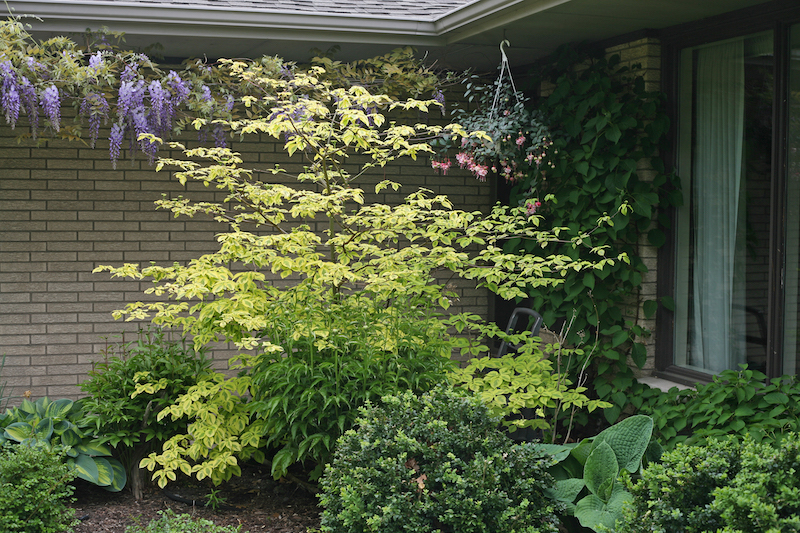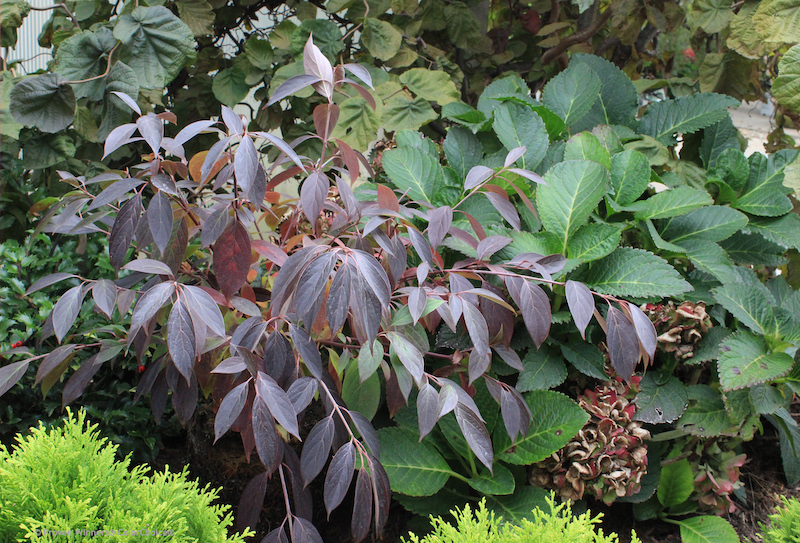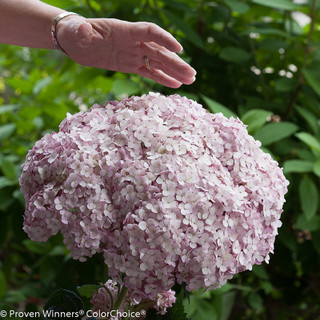Dogwood shrubs and trees are native to most of the United States and are hardy in a number of the USDA growing zones. The variety of cultivars in both tree and shrub forms can be easily combined with other ornamental plants in the home landscape. Dogwood will thrive and establish well in rich, loamy soil that is well draining, but consistently moist. Well-established dogwood shrubs are much more likely to tolerate short periods of drought and heat. Add named cultivars of Red Twig Dogwood to a mixed native hedgerow planting to attract and feed local wildlife.
Plant Dogwood trees, Cornus florida, as the focal point of a spring bulb garden or as a shade tree next to a patio, deck, or other seating area. The delicate bracts and inner flowers attract all manner of beneficial pollinators and birds while the tree is in bloom during the late spring or early summer. Cornus alba is the shrub form most often referred to as Red Twig or Osier Dogwood. These deciduous shrubs also provide nectar-rich flowers and berries for wildlife, although their main season of interest is winter. The brilliantly colored stems of Red Twig Dogwood brighten up the winter landscape when most other plants are dormant.

Shrubs To Plant With Dogwood
Many shrubs make good companions for Dogwood. All Dogwoods like to grow in slightly acidic soil and will perform best alongside other shrubs that like a lower pH soil. Snowberry, Mahonia, Rhododendron, and other broadleaf evergreens are good choices for moderate climates such as those in USDA zones 5-8.
Deciduous, early summer flowering shrubs are a good option for those in the colder growing zones. Consider planting abelia, smoke bush, viburnum, and hydrangeas with Dogwood. These deciduous shrubs will make way for the brightly colored stems of Dogwood in the winter. Other evergreen shrubs such as arborvitae and juniper will provide a lovely solid green backdrop for Dogwood that does not change no matter the season.

Photo by F. D. Richards, unmodified, Flickr, copyright CC BY-SA 2.0 DEED
Perennials To Plant With Dogwood
Combining perennials with Dogwood is where the real fun is. There is a wide variety of foliage shapes and colors to choose from among perennials. Evergreen grasses such as sedges, carex, or mondo grass can be effectively used as ground cover with Dogwoods. Such plantings will look great all year and make for very low-maintenance weed suppression. Other low-growing ornamental grasses such as blue fescue and japanese forest grass also provide ground cover while contrasting with the dark leaves of Dogwood during the summer months.
Planning for a winter landscape is easy with just a few key perennials and any cultivar of Red Twig Dogwood. Select perennials that are semi-evergreen like hellebores, iris, or autumn-blooming sedum for stunning silhouettes in the winter landscape. Coneflowers, black-eyed susan, and agastache have prolific flowers during the summer that can be left to develop into seeds for feeding wildlife through the winter while also adding a layer of texture to the winter landscape.

Annuals To Plant With Dogwood
Annual plants must be carefully selected to grow alongside Dogwood shrubs. The dense mass of branches can easily overwhelm most annual plants or simply look out of scale. Planting hardy annuals that also self-seed provides a more natural, relaxed look that works well with native plants such as Dogwood. Try planting cosmos, cornaria, poppies, and nigella, which have enough height to show up against large plantings of Dogwood.
Best Companion Plants For Dogwood in Containers
Dogwood is a difficult plant to grow in a container for more than a couple of years at a time. Its extensive root system requires soil that stays consistently moist and does not dry out often or for long periods. Good container companions include coral bells, ferns, impatiens, and begonias, which all prefer a little shade and moist soil. Planting these colorful, blooming plants around a central Dogwood provides some shade for the smaller plants and gives the container a full look.
Plants Not To Grow With Dogwood
Plants that attract mildew like comfrey, bee balm, or any of the Cucurbit family (squashes and cucumbers) can easily transmit downy or powdery mildew to Dogwood. Dogwoods are highly susceptible to fungal diseases, which can dramatically reduce their growth. Plants that prefer a high pH soil also may not perform well when planted with Dogwood. Lilacs, forsythia, and mock orange all need alkaline soil to bloom well and will languish when planted in highly acidic soil.
Best Plants To Grow With Dogwood
For a successful design with Dogwoods, plant native shrubs and perennials that thrive in consistently moist but well-draining soil. Think about what each plant looks like during the winter months since that is one of the best times to view the brilliant stems of Dogwood. Plants with sturdy and long-lasting seed heads, semi-evergreen or evergreen ornamental grass, and other cultivars of Dogwood all make an impactful, four-season grouping. For spring through summer color, plant Sogwood with abelia, smoke tree, hydrangea, and viburnum, and enjoy the easy care of a mixed shrub border.
 |
Author Robbin Small - Published 9-13-2023 |




